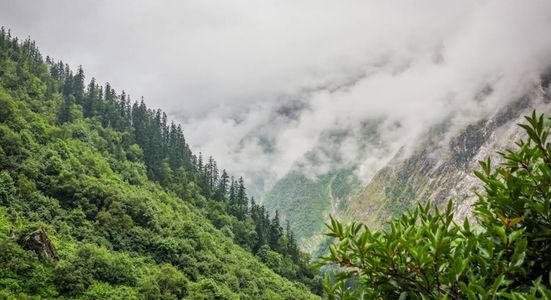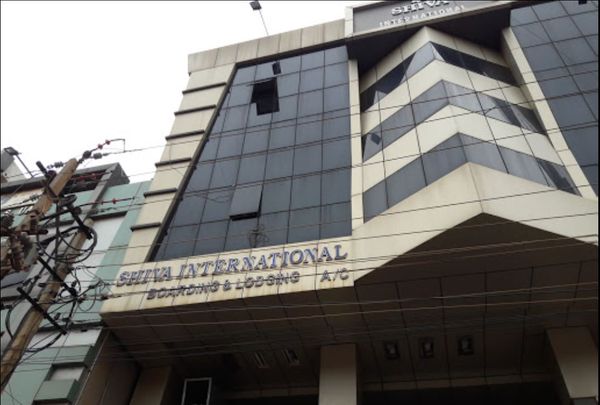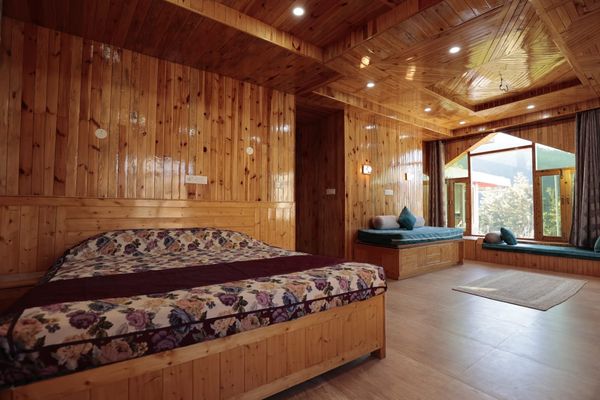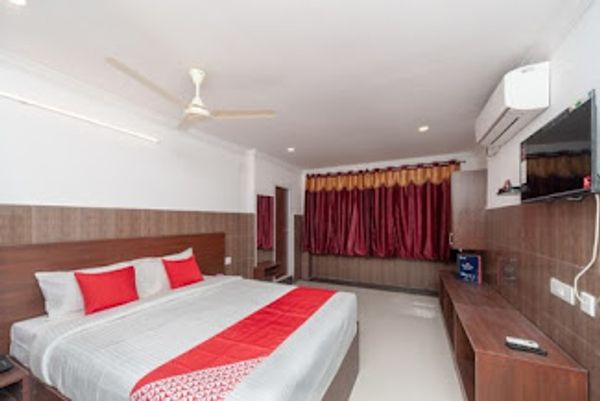Chasing Monsoon Trails: A Journey into Himalayan Wildlands
 Deepanshu Negi
19 Jul, 2025
13 mins read
5
Deepanshu Negi
19 Jul, 2025
13 mins read
5

Introduction
The Himalayas are one of the most beautiful places on Earth. During the monsoon season, these mountains come alive in ways that few other places can match. Rainfall turns dry slopes into green carpets, rivers swell with fresh mountain water, and the forests echo with the calls of birds and animals. This is a time when nature puts on a magical show, and exploring the wildlands of the Himalayas during the monsoon is an unforgettable experience.
What Makes the Monsoon Season Special
Monsoon is more than just rain. It is a time of renewal for the land and its creatures. In the Himalayan region, the dry summer months leave the landscape dusty and tired. When the rains arrive in June and July, everything changes. Grass grows quickly, trees regain their deep green color, and flowers start to bloom across the valleys.
Wild animals also become more active. Birds sing to mark their territory, frogs call out for mates, and deer can be seen grazing in open meadows. This burst of life makes the monsoon season perfect for nature lovers, photographers, and hikers who want to experience the wild in its raw form.
Best Places to Visit in the Himalayas During Monsoon
1. Valley of Flowers, Uttarakhand
- Location: Chamoli district, Uttarakhand
- Altitude: Around 3,500 meters above sea level
- Best Time to Visit: July to September
Why Visit:
- Home to more than 500 species of alpine flowers like blue poppies, orchids, and marigolds.
- Surrounded by snow-covered peaks and lush green meadows.
- Declared a UNESCO World Heritage Site due to its rich biodiversity.
- A great spot for photography, trekking, and nature walks.
- Easy to combine with a spiritual visit to Hemkund Sahib, a Sikh pilgrimage site nearby.
2. Tawang, Arunachal Pradesh
- Location: Western Arunachal Pradesh, near the Bhutan border
- Altitude: Around 3,000 meters above sea level
- Best Time to Visit: June to September
Why Visit:
- Tawang Monastery, one of the largest Buddhist monasteries in India.
- Misty landscapes, deep valleys, and flowing waterfalls during the monsoon.
- Amazing views of the Himalayas wrapped in clouds and fog.
- Local culture rich with Tibetan Buddhist traditions.
- Spot rare birds and Himalayan animals in the forests nearby.
3. Dzongu, Sikkim
- Location: North Sikkim, near the Kanchenjunga Biosphere Reserve
- Altitude: 1,200–1,800 meters above sea level
- Best Time to Visit: July to October
Why Visit:
- A reserved area for the Lepcha community, known for sustainable living.
- Waterfalls are in full flow during the monsoon, making the place scenic.
- Surrounded by virgin forests, rivers, and small traditional villages.
- Ideal for eco-tourism, village walks, and peaceful getaways.
- Fewer tourists compared to popular Sikkim destinations like Gangtok or Pelling.
4. Munsiyari, Uttarakhand
- Location: Pithoragarh district, Uttarakhand
- Altitude: Around 2,200 meters above sea level
- Best Time to Visit: July to September
Why Visit:
- Offers stunning views of Panchachuli peaks, often shrouded in monsoon clouds.
- Known as the "Little Kashmir" of Uttarakhand.
- Perfect for short treks like Khaliya Top and Thamri Kund.
- Experience rural Himalayan life through homestays and local cuisine.
- Rich in birdlife, including Himalayan griffons, eagles, and pheasants.
5. Kalimpong, West Bengal
- Location: Eastern Himalayas, close to Darjeeling and Sikkim borders
- Altitude: Around 1,250 meters above sea level
- Best Time to Visit: June to September
Why Visit:
- Beautiful during the rains with lush tea gardens, rivers, and forests.
- Home to peaceful monasteries and colonial architecture.
- Less crowded than Darjeeling, offering a quiet mountain retreat.
- Great for walks along forest paths and local markets with handmade goods.
- Offers great views of the Teesta River and distant hills.
6. Chopta, Uttarakhand
- Location: Rudraprayag district, Uttarakhand
- Altitude: Around 2,600 meters above sea level
- Best Time to Visit: June to August
Why Visit:
- Base for the Tungnath Temple Trek, one of the highest Shiva temples in the world.
- Meadows and forests become lush green during the monsoon.
- Rich in flora and fauna, part of the Kedarnath Wildlife Sanctuary.
- Perfect for spotting Himalayan monals and musk deer.
- Clean and peaceful, ideal for nature lovers and birdwatchers.
7. Ziro Valley, Arunachal Pradesh
- Location: Lower Subansiri district, Arunachal Pradesh
- Altitude: Around 1,500 meters above sea level
- Best Time to Visit: June to September
Why Visit:
- Famous for its terraced rice fields and bamboo huts.
- The monsoon adds beauty to the green landscape and tribal villages.
- Home to the Apatani tribe with a unique culture and farming techniques.
- Misty mornings and colorful festivals make it a great cultural escape.
- Ideal for slow travel, birding, and exploring tribal traditions.
8. Spiti Valley, Himachal Pradesh (Rain Shadow Area)
- Location: Lahaul-Spiti district, Himachal Pradesh
- Altitude: Around 4,000 meters above sea level
- Best Time to Visit: June to early September
Why Visit:
- Lies in the rain shadow of the Himalayas, making it mostly dry even during monsoon.
- Stunning high-altitude desert landscapes, monasteries, and ancient villages.
- Visit Key Monastery, Chandratal Lake, and Dhankar Monastery.
- Clear skies for stargazing at night despite the monsoon in other parts.
- Great for adventure travelers looking for a unique Himalayan experience.
Trekking During the Monsoon
Trekking in the monsoon is different from other times of the year. Trails are often wet, and leeches can be found in forested areas. But if you are ready for some adventure, this is a great time to walk through clouds, watch waterfalls, and feel close to nature.
It is important to have the right gear. Waterproof shoes, a raincoat, and dry bags for electronics are a must. It’s also wise to travel with a guide, especially in remote areas, since some paths may become risky due to landslides or heavy rain.
The Wildlife Experience
Monsoon is a great time for spotting wildlife in the Himalayas. Many animals are active after the first rains. You may see barking deer, langurs, and even the rare red panda if you are lucky. Insects like butterflies and dragonflies are also seen in large numbers.
Birdwatchers will enjoy this season the most. From brightly colored Himalayan monals to various species of thrushes, warblers, and cuckoos, the skies and trees are full of birds. Early mornings, just after the rain, are the best times for spotting wildlife.
Staying with Local Communities
One of the best ways to enjoy the Himalayan wildlands during the monsoon is by staying in homestays. Local people open their homes to travelers, and you get to eat home-cooked food, hear stories, and learn about their way of life.
In places like Dzongu and Munsiyari, you can find family-run guesthouses where the focus is on sustainability. The locals often act as guides, helping you explore the forests, waterfalls, and viewpoints without damaging the environment.
Capturing the Beauty of the Monsoon
If you are a photographer or love taking pictures, monsoon is a dream come true. The skies are dramatic, the clouds move fast, and the colors of nature are more intense. Rainbows often appear after short spells of rain, and fog adds mystery to every shot.
Carry a weatherproof camera or keep it protected. A lens cloth and plastic cover can help you shoot even in light rain. Early mornings and late afternoons often offer the best light for photos.
Safety and Responsible Travel
Monsoon in the mountains can be risky if you’re not prepared. Landslides, roadblocks, and sudden weather changes are common. Always check the local forecast and avoid risky routes during heavy rain.
Travel responsibly by not littering, staying on marked trails, and not disturbing wildlife. Respect local customs, and don’t play loud music in forest areas. This helps protect the delicate balance of these wildlands.
Why Monsoon Adventures Matter
Exploring the Himalayas in the monsoon teaches us the power and beauty of nature. It also shows how everything is connected the rain, the trees, the rivers, and the animals. When you walk through these wildlands, you start to understand how life works in the mountains.
Traveling during this time supports local communities who depend on eco-tourism. It also raises awareness about the need to protect natural spaces. The more people see and appreciate these places, the better chance they have to survive in the future.
Conclusion
Chasing monsoon trails in the Himalayan wildlands is not just about travel. It is about reconnecting with nature, finding peace in the sound of rain, and seeing life unfold in its most natural form. Whether you are trekking through flower-covered valleys or sitting by a foggy window in a mountain home, the monsoon offers moments that stay with you long after the journey ends.
Pack your rain gear, keep an open heart, and follow the trails where the rain leads. The Himalayas are waiting.
Written By:
Deepanshu Negi



Hotels at your convenience
Now choose your stay according to your preference. From finding a place for your dream destination or a mere weekend getaway to business accommodations or brief stay, we have got you covered. Explore hotels as per your mood.


